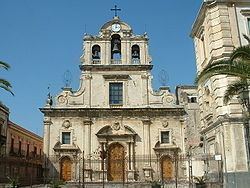Elevation 53 m (174 ft) Time zone CET (UTC+1) Area 215.8 km² | Demonym(s) Lentinesi Dialing code 095 Postal code 96016 | |
 | ||
Weather 16°C, Wind E at 11 km/h, 49% Humidity | ||
Lentini (Sicilian: Lintini), historically Leontini or Leontinoi (Ancient Greek: Λεοντῖνοι), is a town and comune in the Province of Syracuse, South East of Sicily (Southern Italy).
Contents
Map of 96016 Lentini, Syracuse, Italy
History
The city was founded by colonists from Naxos as Leontini in 729 BC, which in its beginnings was a Chalcidian colony established five years earlier.
It is virtually the only Greek settlement in Sicily that is not located on the coast, founded around 6 miles inland. The site, originally held by the Sicels, was seized by the Greeks owing to their command on the fertile plain in the north. The city was reduced to subject status in 494 BC by Hippocrates of Gela, who made his ally Aenesidemus its tyrant. In 476 BC, Hieron of Syracuse moved the inhabitants from Catana and Naxos to Leontini.
Later on, the city of Leontini regained its independence. However, as a part of the inhabitants efforts to retain their independence, they invoked more than once the interventions of Athens. It was mainly the eloquence of Gorgias of Leontini which led to the abortive Athenian expedition of 427 BC.
In 422 BC, the Greek city-state of Syracuse supported the oligarchs against the people and received them as citizens, Leontini itself being forsaken. This led to a renewed Athenian intervention. Initially as a diplomatic one, the exiles of Leontini joined the envoys of Segesta in persuading Athens to undertake the great Sicilian Expedition of 415 BC.
After the failure of the Expedition, Leontini became subject to Syracuse once more. The city's independence was guaranteed by the treaty of 405 BC between Dionysius and the Carthaginians, but it was soon lost again. The city was finally stormed by Marcus Claudius Marcellus in 214 BC.
In Roman times it seems to have been of small importance. It was destroyed by the Saracens in 847 AD, and almost completely ruined by the earthquake of 1693. Until the middle of the 20th century, Lentini was regarded by travellers as a malarial stopover to Syracuse of minor historical importance.
The ancient city is described by Polybius as lying in a valley between two hills, and facing north. On the western side of this valley there was a river flowing with a row of houses on its western bank below the hill. At each end was a gate, the northern gate leading to the plain, the southern, at the upper end, leading to Syracuse. On each side of the valley there was an acropolis, lying between precipitous hills with flat tops, over which buildings extended. The eastern hill still has the remains of a strongly fortified medieval castle, in which some writers are inclined (though wrongly) to recognize portions of the Greek masonry.
Excavations were made in 1899 in one of the ravines in a Sicel necropolis of the third period; explorations in the various Greek cemeteries resulted in the discovery of some fine bronzes, notably a lebes.
Attractions
Lentini's prime monuments include:
Economy
Lentini's economy is mainly based on agriculture, and less remarkably on woodcraft and handicraft production.
